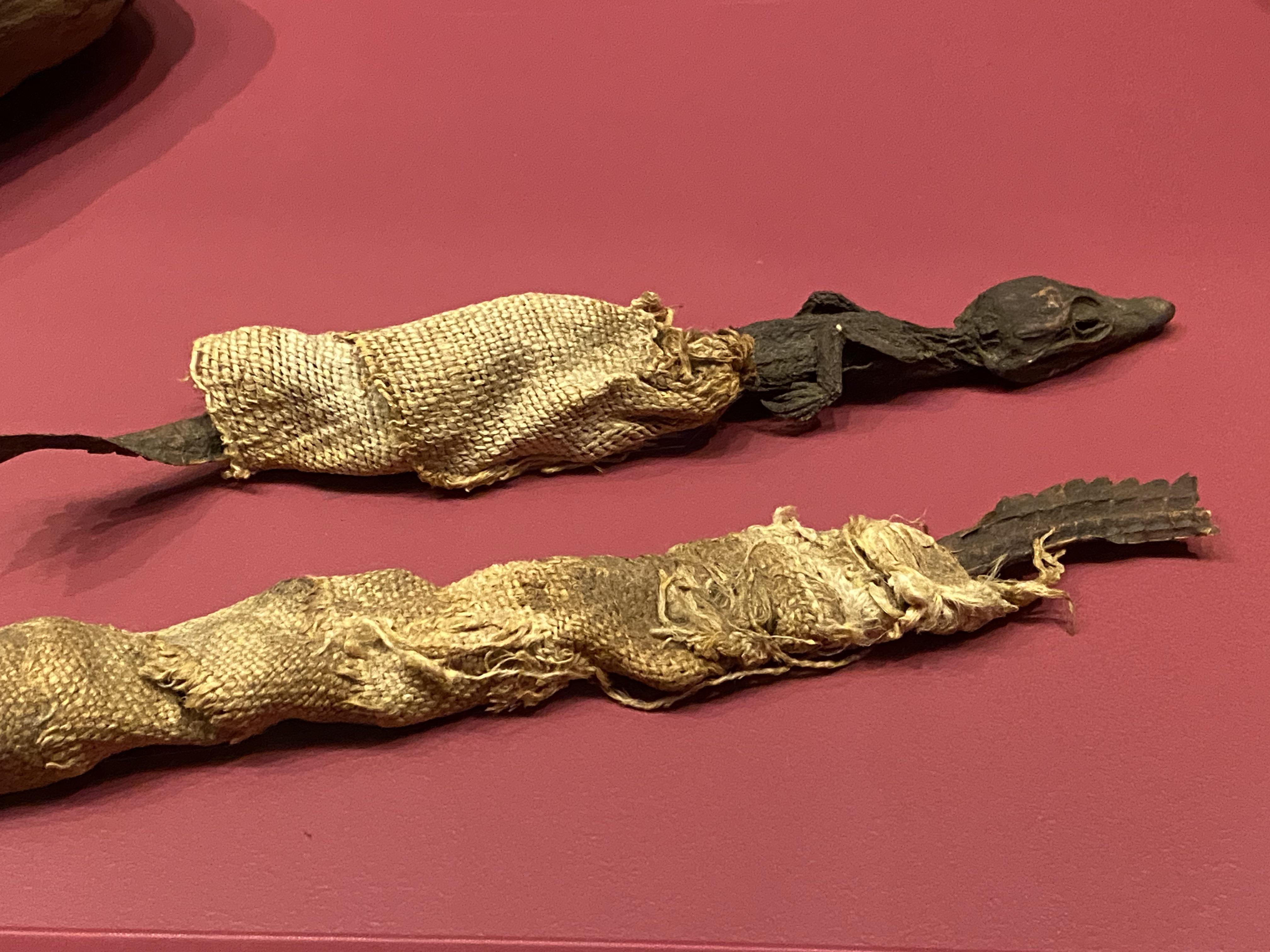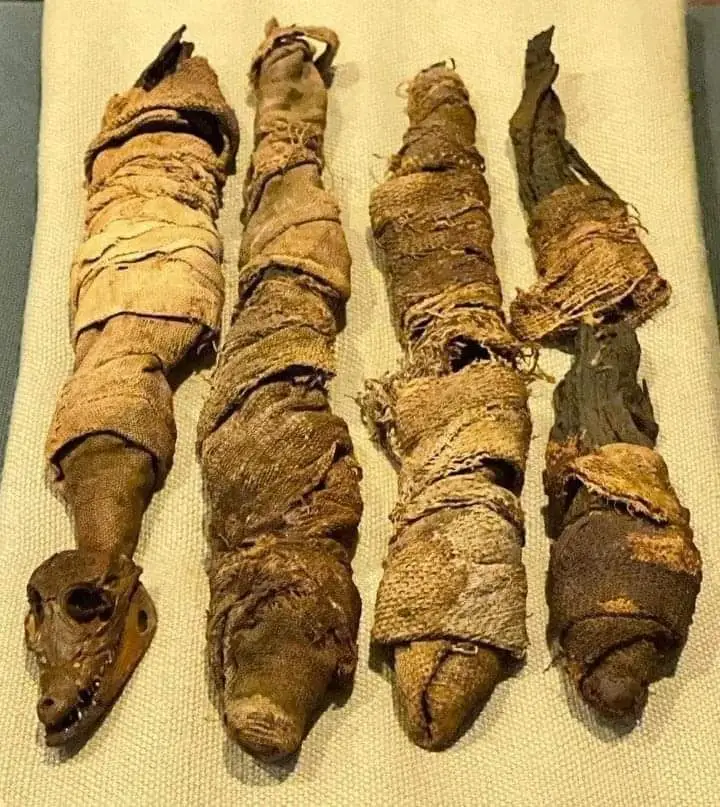Introduction
Nestled within the vast collection of the National Museum of Natural History, one of the Smithsonian’s renowned institutions in Washington, D.C., lies a captivating and enigmatic display – four mummified baby crocodiles from the Ptolemaic or Roman era of ancient Egypt, spanning the period from 332 BC to 250 AD. These diminutive yet intriguing artifacts offer a tantalizing glimpse into the rich cultural and religious traditions of a civilization that captivates the imagination of people around the world.

As visitors step into the museum’s grand halls, they are immediately drawn to the display case housing these remarkable mummies. The sight of these perfectly preserved, tiny reptilian forms, swathed in intricate wrappings, evokes a sense of wonder and curiosity. What stories do these mummies hold? Why were they mummified, and what was their significance in the ancient Egyptian world?
In this blog post, we will delve into the fascinating history and significance of these mummified baby crocodiles, exploring the cultural and religious context that gave rise to this unique practice. We will uncover the insights they provide into the beliefs, rituals, and daily life of the Ptolemaic and Roman-era Egyptians, as well as the ongoing efforts to preserve and study these remarkable artifacts.
The Cultural and Religious Significance of Crocodile Mummies
In ancient Egypt, crocodiles held a special place in the pantheon of deities and were closely associated with the powerful god Sobek, the god of the Nile, fertility, and military might. Crocodiles were revered for their strength, ferocity, and connection to the life-giving waters of the Nile, which were essential to the prosperity of the Egyptian civilization.
During the Ptolemaic and Roman periods, the cult of Sobek gained significant prominence, with numerous temples and shrines dedicated to the crocodile god throughout the Nile Valley. It was during this time that the practice of mummifying crocodiles, both adult and young, became increasingly common.

The mummification of crocodiles, including these four baby specimens on display at the Smithsonian, was not merely a means of preserving the physical remains of the animals. Rather, it was a deeply symbolic act, imbued with religious significance and a belief in the afterlife. By mummifying the crocodiles, the ancient Egyptians were ensuring that these sacred creatures would continue to exist and serve their god Sobek in the next world.
The careful attention to detail in the mummification process, including the intricate wrappings and the preservation of the crocodiles’ distinctive features, suggests that these were not mere pets or random animals, but rather revered creatures with a profound spiritual purpose. The mummification of crocodiles was likely carried out by skilled priests or embalmers, who followed meticulous rituals and techniques to ensure the proper preparation of the bodies for the afterlife.
Insights into Ancient Egyptian Life and Beliefs
The mummified baby crocodiles on display at the Smithsonian offer a unique window into the daily life and beliefs of the ancient Egyptians during the Ptolemaic and Roman periods. These artifacts provide valuable insights into the cultural and religious practices that were central to the Egyptian worldview.
One of the most fascinating aspects of these mummies is the information they can reveal about the ancient Egyptians’ relationship with the natural world and their reverence for the crocodile as a sacred creature. By mummifying these young crocodiles, the Egyptians were demonstrating their deep respect and veneration for the animal, as well as their belief in the continuity of life beyond the physical realm.

Furthermore, the presence of these mummified crocodiles in the National Museum of Natural History suggests that they may have been part of a larger collection or necropolis dedicated to the cult of Sobek. This would indicate that the ancient Egyptians placed great importance on the worship and preservation of these creatures, which were seen as embodiments of the divine.
In addition to their religious significance, the mummified crocodiles can also provide insights into the ancient Egyptians’ scientific and technological knowledge. The techniques used to mummify these animals, including the preservation of their internal organs and the intricate wrappings, demonstrate a sophisticated understanding of anatomy, embalming, and preservation methods.
By studying the physical characteristics and materials used in the mummification process, researchers can gain valuable information about the Egyptians’ medical and scientific practices, as well as their artistic and craftsmanship abilities. This knowledge can then be used to further our understanding of the ancient Egyptian civilization and its lasting impact on the world.
The Ongoing Study and Preservation of the Mummies
The mummified baby crocodiles on display at the Smithsonian’s National Museum of Natural History are not merely static artifacts; they are the subject of ongoing study and preservation efforts by a dedicated team of researchers, curators, and conservators.
Through advanced scientific techniques, such as X-ray analysis, CT scanning, and DNA testing, these mummies are being examined in unprecedented detail, revealing new insights into their origins, the mummification process, and even the lives and deaths of the crocodiles themselves. By studying the physical remains and the materials used in the mummification process, researchers can gain a deeper understanding of the cultural and religious practices that surrounded the veneration of these sacred animals.

In addition to the scientific study of the mummies, the museum’s conservation team is also responsible for the meticulous preservation of these delicate artifacts. This involves carefully monitoring the environmental conditions of the display case, controlling temperature, humidity, and lighting levels to ensure the long-term stability and protection of the mummies.
The team also employs specialized techniques, such as the use of inert gases and custom-made supports, to minimize the risk of damage or deterioration. These preservation efforts are essential in ensuring that these mummies can be enjoyed and studied by visitors and researchers for generations to come.
Furthermore, the museum’s educational programs and public outreach initiatives play a crucial role in sharing the stories and significance of these mummified crocodiles with the wider public. Through interactive exhibits, educational resources, and engaging presentations, the museum aims to inspire curiosity, foster a deeper understanding of ancient Egyptian culture, and encourage a appreciation for the ongoing efforts to preserve these remarkable artifacts.
Conclusion
The mummified baby crocodiles on display at the Smithsonian’s National Museum of Natural History are not merely curious relics of the past; they are tangible links to the rich cultural and religious traditions of ancient Egypt. These diminutive mummies, preserved with meticulous care and attention, offer a glimpse into the beliefs, practices, and daily life of a civilization that continues to captivate the imagination of people around the world.
As visitors step into the museum’s halls and encounter these mummified crocodiles, they are transported back in time, confronted with the enduring legacy of a people who revered the natural world and its sacred creatures. Through the ongoing study and preservation of these artifacts, we can continue to uncover the secrets of the past and deepen our understanding of the remarkable achievements of the ancient Egyptian civilization.
Whether you are a history enthusiast, a student of archaeology, or simply someone who marvels at the wonders of the natural world, the mummified baby crocodiles at the Smithsonian are a must-see destination. They serve as a testament to the enduring power of human ingenuity, creativity, and reverence for the natural world, inspiring us to continue exploring and preserving the rich tapestry of our shared cultural heritage.
